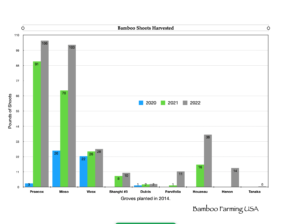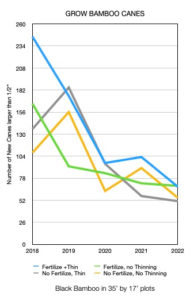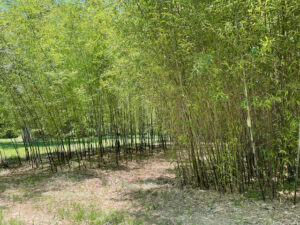How Soon will a Bamboo produce Shoots?
Thinning Bamboo is Necessary
Question: Should you thin a new planting of bamboo as it grows towards maturity? Is that labor necessary? Or can you just let it grow naturally until mature?
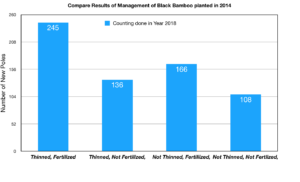
Note: The thinned poles can be chipped and returned to the grove as mulch. Don’t waste them. Use them or sell them. Bamboo chips are long and short shreds that bind together when used as mulch. The bamboo shreds resist scattering. They stay in place. I use them for mulch on the bamboo groves, and, especially, I use them to pave my dog yard. Tree chips scatter out of the dogs’ path in a day. The Bamboo strips hold together. They pack down.
Feed bamboo leaves to livestock. Waste not, want not.
The Test: In 2017, its third year, I divided my black bamboo grove into four equal sections. One section, I thinned, mulched and fertilized; the second section, I fertilized, but did not thin. The third section, I thinned but did not fertilize. The fourth section was the control: no thinning, no mulch, no fertilizing. I kept all sections weed free and irrigated.
Result: In 2018, Year Four, I thinned the two sections labeled “thinned” before counting the new canes. Then I counted new canes in each of the four plots. Thinned, fertilized: 245 canes. Thinned, no fertilizer: 136 canes. Not thinned, fertilized: 166 canes. Control: 108 canes.
I counted new canes after I thinned the sections. (I remove leaning canes, crowded canes, small canes, dead canes.)
The unthinned section grew new canes only along its sunny south edge. It did not grow canes in its center. In my location, bamboo grows best on the southwest corner of the plot.
Observation: Our unthinned sections are cluttered with small canes from years one, two, and three. The crowded canes make it difficult to enter, to fertilize and to mulch. The visual effect is crowded and messy. These old, early, small canes die in the shade of the newer taller canes.
Unthinned groves have less light in the center of the grove. New shoots tend to grow at the sunny edges, not in the shaded interior.
Conclusion: Thin your maturing groves beginning in Year Three. You will see improved maturity and productivity in Year Four.
Irrigate at least an inch a week during the growing season, more if the temperature is above 95°F (35°C).
Mulch and fertilize.
Note: We will continue this experiment as the years go by.
Notes from June 2020, Year Six
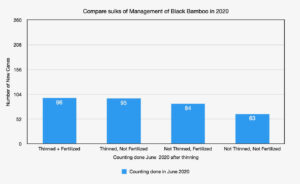
Black bamboo is smaller than the other twelve varieties on my research farm. Its smaller shoots weigh less. I did not intend to sell shoots out of the black bamboo grove. Instead my goal is to sell black bamboo poles. The graph below shows that in Year Six, the thinned groves have more new poles than the un-thinned groves.
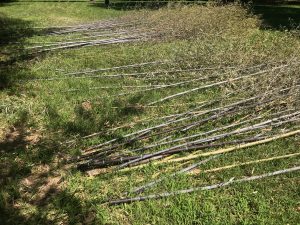
The two thinned sections produced a lot of black poles. The poles littered the ground on all four sides of the grove. Black bamboo leans a lot especially after rain. We go around the perimeter of the grove and cut out the leaners.
Thinning allows larger and more poles to grow each spring. These poles are distributed within the plot. In addition, the thinned poles can be sold as poles as well as being chipped for mulch or made into charcoal.
Processing Black Poles
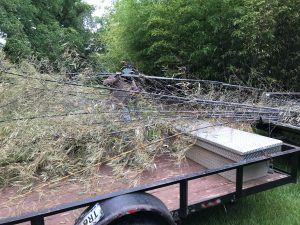 The photo of the trailer being loaded shows a few of the black poles to be added to the pile of poles waiting to be chipped for mulch. This cleanup occurred before I decided to save some of the poles for heat treating/torching and selling at the local farmers market.
The photo of the trailer being loaded shows a few of the black poles to be added to the pile of poles waiting to be chipped for mulch. This cleanup occurred before I decided to save some of the poles for heat treating/torching and selling at the local farmers market.
To prepare the poles for torching, we cut off the tops with branches. These tops with branches will be mulched. We use the lower part of the pole that has no branches for sellable black poles. It is too much labor to cut off the branches and smooth the stubs. Also the pole with branches is no longer round. Above the branches is a groove that detracts from the beauty of the pole.
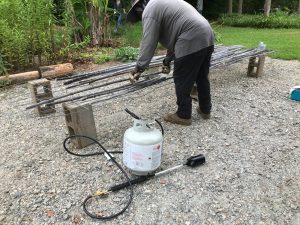 We laid the poles onto a raised metal grid over the gravel driveway. Then we torched them. The heat of flame brings out the natural oils almost instantly. The poles turn shiny black. Black poles become beautiful poles for ornament, walking sticks, and crafting.
We laid the poles onto a raised metal grid over the gravel driveway. Then we torched them. The heat of flame brings out the natural oils almost instantly. The poles turn shiny black. Black poles become beautiful poles for ornament, walking sticks, and crafting.
A friend of a friend suggested that the untouched poles also were attractive. She said that the grey “wash” over the basic black of the pole was like a sophisticated decor. Accordingly, I prepared some poles that are torched and some that are not. With my miter saw, I carefully cut each pole so that each end had a node closing the hollow internode. This way the pole looks better and is stronger.
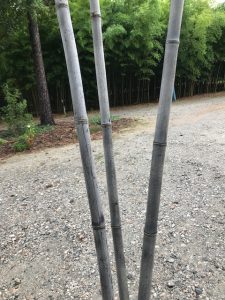 I was a vendor at the local farmers market today. One man bought two of the poles with the grey coating, and, two with the shiny black. He bought them for walking sticks.
I was a vendor at the local farmers market today. One man bought two of the poles with the grey coating, and, two with the shiny black. He bought them for walking sticks.
The other purchasers of the bamboo “sticks” were children. The sticks became batons, rifles, spears, pencils to draw in the mud (it rained), airplane wings, and other imaginative items.
One man described to me the various ways that bamboo can be cut and used as a deadly weapon! He was a martial artist.
Photo with three grey poles shows how in my climate, black bamboo tends to have a grey coating over the black skin. Almost like the grey sin of henon, the giant grey bamboo.
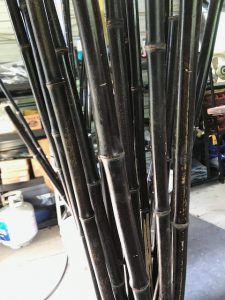 Photo with multiple black poles shows how heat treating removes the grey coating and shows the shiny, handsome black skin.
Photo with multiple black poles shows how heat treating removes the grey coating and shows the shiny, handsome black skin.
Number of New Shoots June 2022, Year Eight
To left is the Thinned/not fertilized grove in year 2022 when grove is eight years old. To the right is the Fertilized/not thinned grove. It is dense with dead old canes. Mostly they are dead from being shaded out. However, some are killed by a common fungus disease.
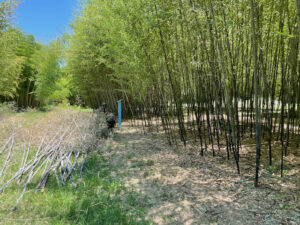
To the right of the photo is the Fertilized and Thinned grove. It is open to sunlight throughout. Behind the Fertilized and Thinned grove is the Fertilized and not thinned. It appears dense.
Beside the thinned grove is the pile of poles thinned just before counting the new green poles of 2022. (Black bamboo new canes are green. They turn black within a year so it is easy to count new canes for the season.)
Thinning makes the grove open and lovely. It gives new shoots space to grow straight up towards the light. Without thinning, they tend to see light off to one side and bend towards that light. The result is poles that curve out to light and then up to more light. They are good for chips only. Thinning also results in more poles harvested each year.
The count for Fertilized-+-Thinned in 2022 is 65 good poles to be made into fishing poles and 27 dead poles. The dead poles died of a fungus disease which is decimating mature bamboo groves in Georgia. Thinning removes the diseased poles and presumably reduces the spread of this fungus.
Moso Produces in Alternate Years
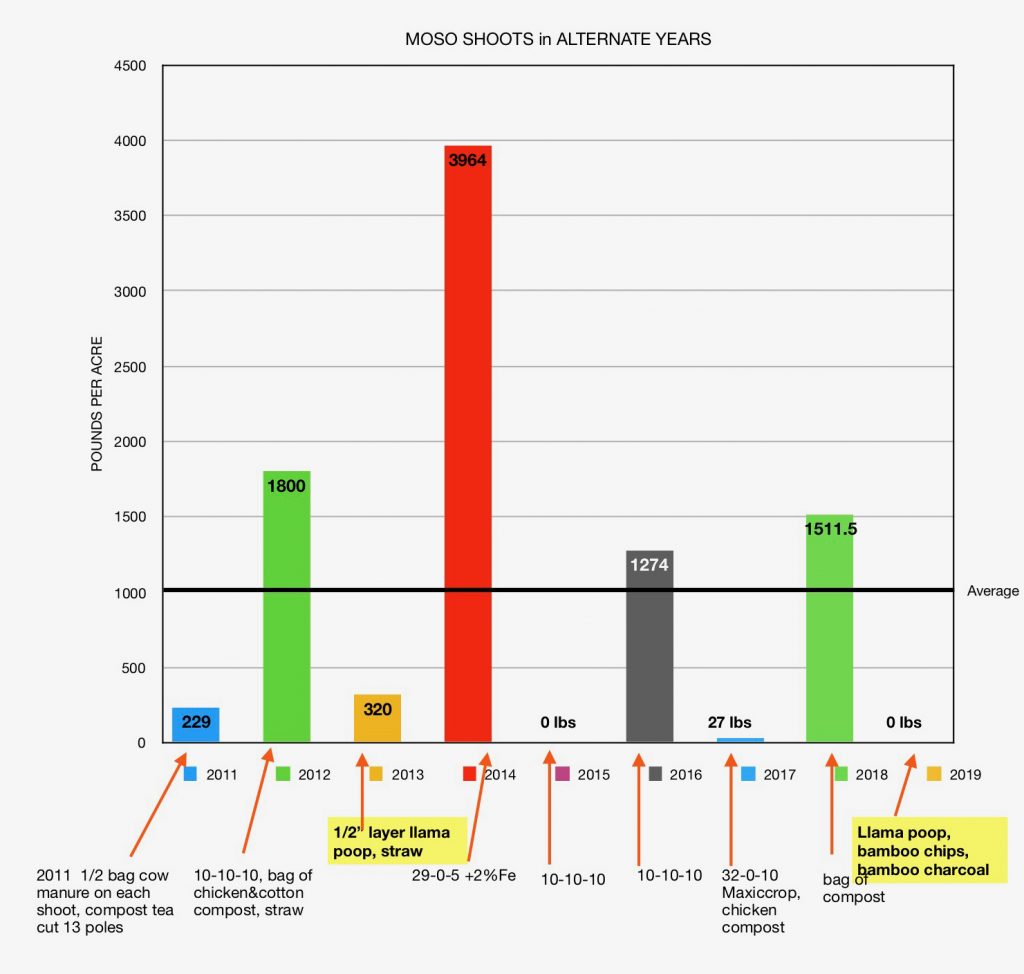
Background: I moved to Perry, Georgia, in October 2010. Robby Russell allowed me to use various of his 20 year old bamboo varieties for research. His moso is from a division of the Anderson clone in the old Silverbrook Cemetary in Anderson, South Carolina. Rufus Fant planted it in the nineteen teens. He mail ordered his moso from California! Amazing to think that a mail order nursery industry existed in the beginning of the twentieth century!
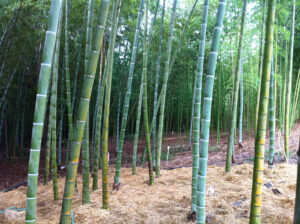
My research plots measure 1000 square feet with dimensions being 32 foot by 32 foot. The moso research plot is adjacent to the dirt access road. I cut away small trees, shrubs, vines, weeds. I had read that moso bamboo in Japan yields from three to ten tons per acre! I was psyched by that high yield!
In 2011 my moso yielded 229 pounds per acre, not even one ton! What is wrong?! Robby and I agreed that I needed to thin the moso to stimulate production. I removed 13 of the smaller canes and a few invasive canes from across the dirt road.
In 2012 yield of shoots was 1800 pounds. Better than the yield in 2011 but less than one ton. I thought that the increase from 2011 was because I thinned the poles in 2011. To increase the yield in 2013, I scattered 10-10-10 fertilizer in the plot. I spread a bag of chicken-and-cotton compost. I placed a handful around each new cane. I mulched with wheat straw. I expected a bigger yield in 2013 because of my fertilizing.
In 2013 the moso did not shoot until April 9, ten days later than in 2011. It took that long for the soil to reach 58°F!! A cold spring delayed harvest and reduced yields in nine out of ten research plots (praecox, henon (2 locations), houzeau, Robert Young (2 locations), dulcis, Bory, golden vivax, bambusoides). Moso yield was 320 pounds. I blamed the low yield on the cold weather and the resulting late start of shooting.
I found a source of llama dung. This remarkable fertilizer allowed the Incas to grow maize at 10,000 feet! That civilization was built on llamas for labor and for dung for fertilizing crops. Llama dung is in pellets with little odor. Its analysis is 1.7 – 0.7 – 1.2 We spread half an inch of llama poop over the entire moso plot. Then we covered it with straw.
In 2014, yield was close to two tons at 3964 pounds. Was llama poop the reason for the jump in productivity?
In 2015 and 2019, I harvested zero shoots. Because my research showed that moso bears in alternate years. I expected great harvest in 2020 if I fertilized with llama dung and mulched with chips or straw. Astonishingly and to my dismay, this grove produced no shoots in 2020. Two years in a row, this moso produced no shoots. What is going on with this grove of moso bamboo!?
On a Monday in 2020, I had noted 5 shoots outside my research plot in the larger grove of which it is part. I had decided not to harvest them because the entire grove except my research plot had been over-harvested for large poles (not by me!!!) two years before and had not recovered. When I returned on Thursday, wild pigs had eaten these 5 shoots from the top down into the base underground. Wild pigs are a new predator of shoots in my experience. Before, predators were squirrels and rabbits and mice… rodents.
Observation: Moso bears in alternate years because it changes its leaves in alternate years. The year that moso changes its leaves, all the leaves turn yellow at once. The ground is littered with yellow leaves.
Moso shoots less in the year that it changes its leaves – or in my case does not shoot at all! A farmer’s income from a moso grove will be less during the year that the moso changes its leaves.
Other Phyllostachys don’t have this alternate year pattern. They lose the oldest leaf on the twig each summer when a new leaf opens and in winter when the oldest leaf dies.
First photo taken in 2011; second, in 2013; Third photo taken in 2019. Expect few shoots (minimal harvest) when you see your grove turn yellow.
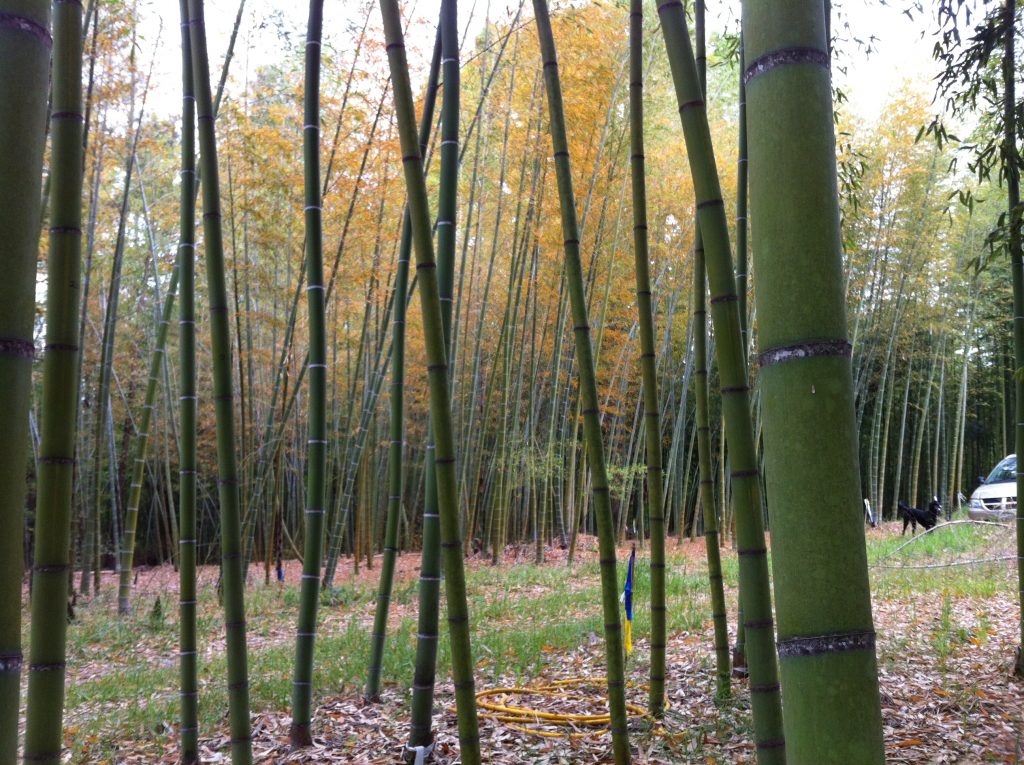
2011
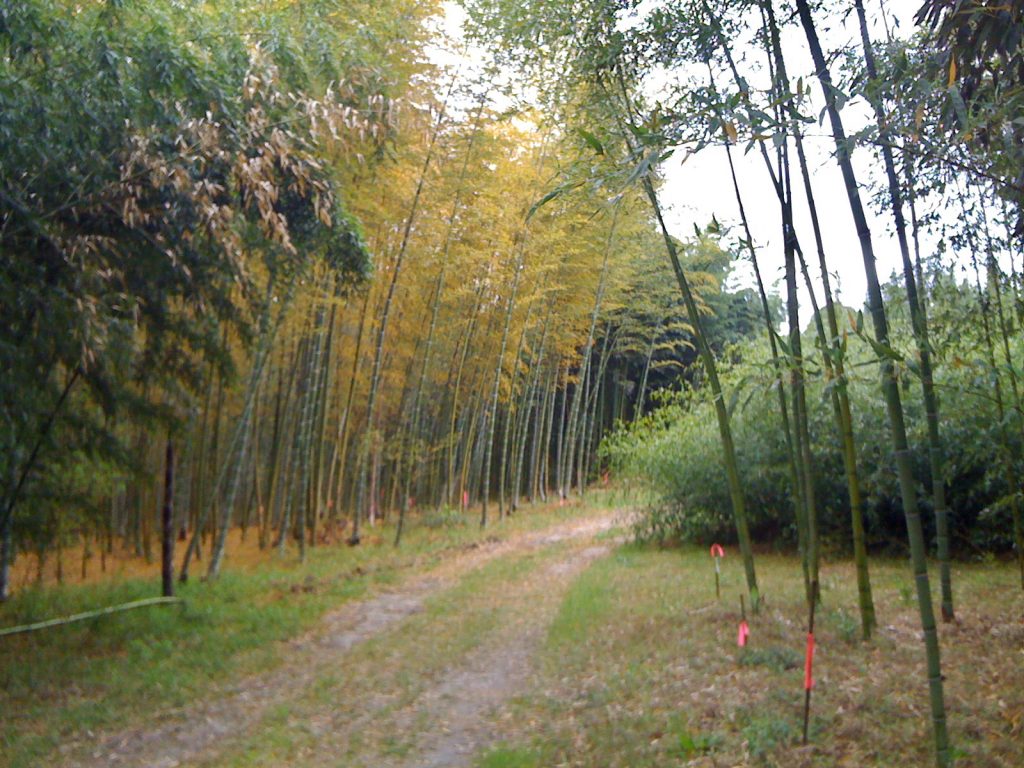
2013
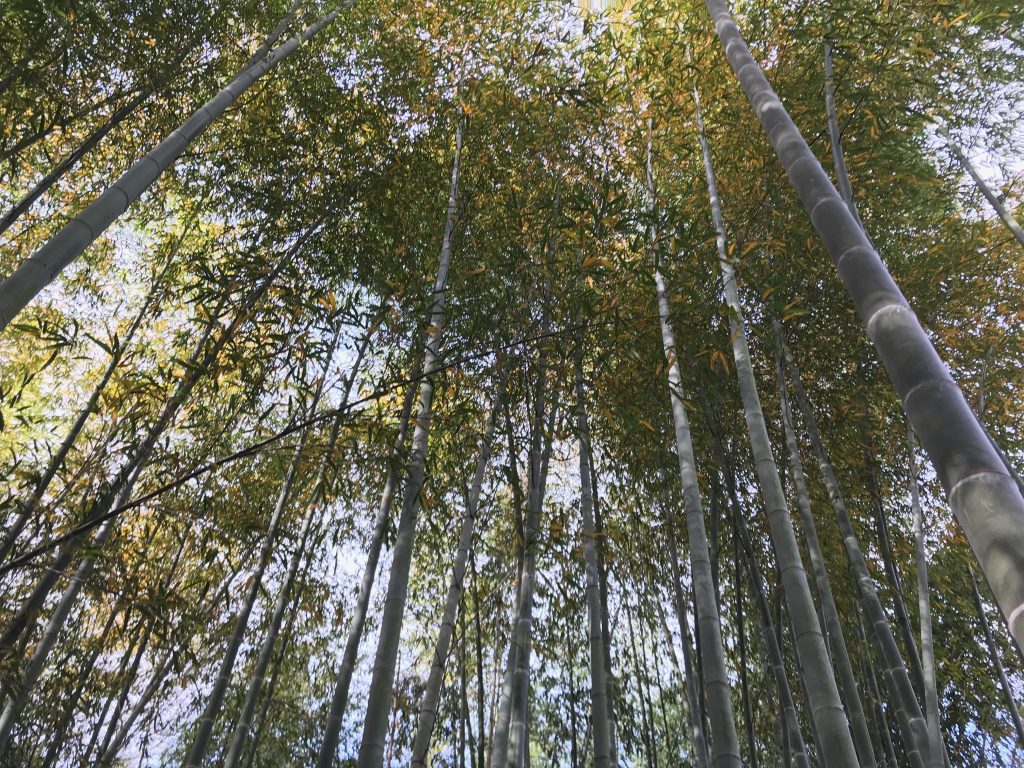
2019
Comments: I have read that careful management can even out the extreme pattern of one-year-on and the next-year-off. In early Japan, this careful management was by necessity. Farmers emptied the contents of stables at the end of each winter onto their moso. Other organic fertilizers including human urine and dung and the dead bodies of pets and livestock were added in addition to the manures, used stable bedding, and hay from the stable.
Moso needs considerable irrigation for maximum production. Kyoto receives sixty inches of rain a year and two-thirds of it occurs from May through September. These are the months of growth of rhizomes. Georgia receives 45 inches of rain a year. Georgia’s rainfall is spread throughout the year. The heavy rain in summer that moso likes is not there. The moso grove that my data comes from is not irrigated.
Conclusion: Adding ample organic matter in addition to manufactured fertilizers often improves yields. Irrigation is essential for high yielding moso bamboo.
Compare Varieties
Observations: Each spring I harvest bamboo shoots to sell and to eat. I work with the following varieties of Phyllostachys.
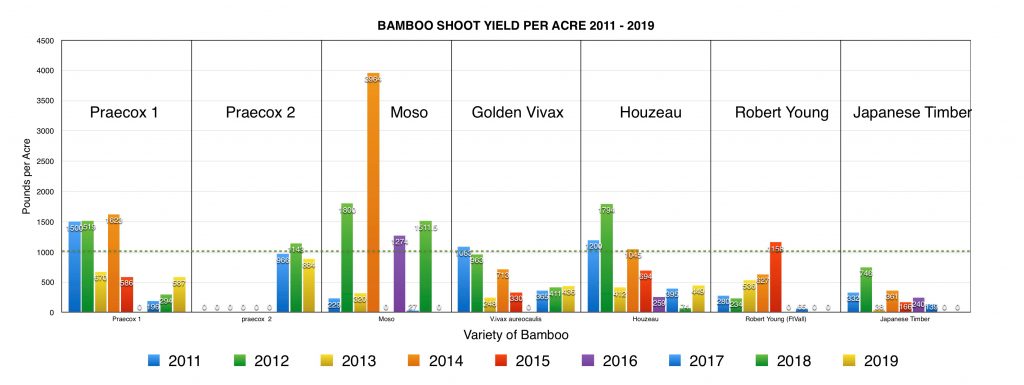
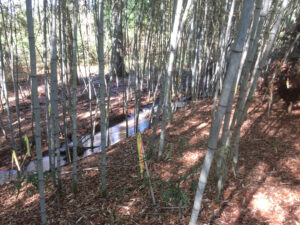
Henon: I work with two groves; one in Fort Valley and one in Bonaire. The grove in Fort Valley does not produce because it is located where the soil does not warm up until shooting time is past. In 2019 the grove flowered and died. The grove in Bonaire has a disease and while this henon does send up a few new canes each spring, they die in early summer. I gave up harvesting shoots in 2016. I thought it was a root disease; county agents surmised it was a leaf disease. We do not know.
Praecox – Early Bamboo. 2011 and 2012 were good years. In 2013, a cold spring reduced yield in Praecox and all other varieties except Robert Young. In 2014, yield came back and increased a bit.
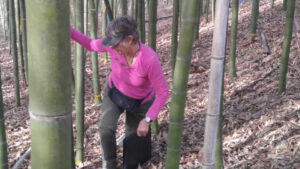 Then in 2015 Production fell. I encouraged the grove to expand to the south by cutting away a competing bamboo with small canes. By 2017, the expansion had created a new research plot: Praecox 2. Why did production fall off in Praecox 1 from 2015 to 2019? One problem was that the nursery just up hill from Praecox 1 drained water into the plot. One third of the plot was too wet for rhizomes to survive. The nursery is now defunct so irrigation water is not killing the rhizomes in one third of the research plot. Praecox 1 may be returning to respectable yearly yields according to the slope of the graph of yield in 2017, 18, and 19.
Then in 2015 Production fell. I encouraged the grove to expand to the south by cutting away a competing bamboo with small canes. By 2017, the expansion had created a new research plot: Praecox 2. Why did production fall off in Praecox 1 from 2015 to 2019? One problem was that the nursery just up hill from Praecox 1 drained water into the plot. One third of the plot was too wet for rhizomes to survive. The nursery is now defunct so irrigation water is not killing the rhizomes in one third of the research plot. Praecox 1 may be returning to respectable yearly yields according to the slope of the graph of yield in 2017, 18, and 19.
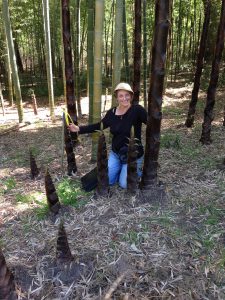
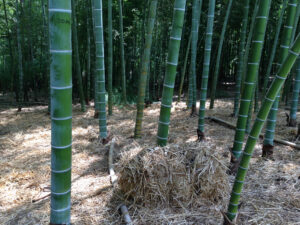 Moso: See above.
Moso: See above.
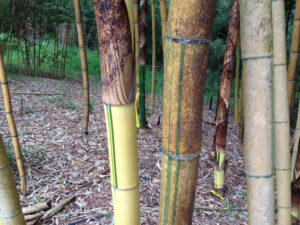 Golden Vivax: Much the same yearly pattern as Praecox 1. I think that the continual harvesting that I am doing requires me to fertilize and mulch more than I have been doing.
Golden Vivax: Much the same yearly pattern as Praecox 1. I think that the continual harvesting that I am doing requires me to fertilize and mulch more than I have been doing.
Golden vivax is less vigorous than the standard green vivax. It will revert to the green. I rogue out the green canes within the research plot. I usually let the green ones outside the plot remain.
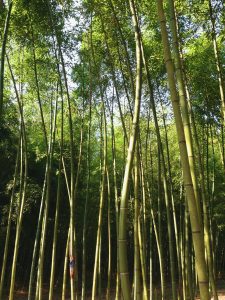
Houzeau: Also a similar pattern to Praecox 1. However, Houzeau’s pattern is different because its low yield in 2016 to 2019 is due to disease. Houzeau is across the dirt road from the sick Henon. In 2015, Houzeau’s yield dropped from 1045 pounds to 695 pounds per acre. A third less productive. I counted two canes with top die-back and 10 canes with necrotic spots at the base of the canes.
It looked to me that the Houzeau had caught the same disease that devastates the henon across the farm road. Field Notes 3/26/2015 “leaves turning yellow”; 6/30/2015 “cleared 20 canes cut into 6′ lengths”. These were cleared because they were dead or dying. 9/9/2015 “Leaves look a bit spotted.” 8/25/ 2016 “Lots of dead poles – drought? disease?” 11/30/2016: “12 or 13 canes dead, rest look OK”. 2/7/2017: “15 canes with dead tops; 3 dead canes”, “a lot of the 2016 canes have dead tops and live leaves at lowest level.” 2/20/2018: “18 dead tops – Far too much light – Soil seems dead & dry”.
6/19/2019 Pulled 16 dead poles from Houzeau“. 7/5/2019 Chipped piled poles of poles onto Houzeau; 7/24/2019 llama poop. 7/31/2019 “Darryl cut down all dead poles; poles are dying from top down; some have black spots, many do not”. By 9/11/2019 Houzeau has llama poop plus bamboo charcoal.
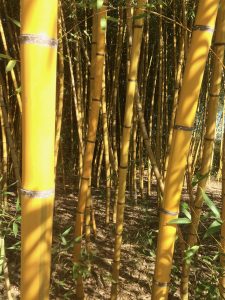 Robert Young: The yield pattern of Robert Young from 2011 to 2015 is different from the other bamboos. Robert Young increased yield in 2012 when all other bamboos decreased. Spring was cold. However, Robert Young is a late shooter so avoided the worst of the unusual cold weather. It is located in a warm site where the sun hits directly from sunup to sundown. Also for the first two years, Robert Young was the bamboo that I was able to irrigate. It is located across from a well house so I could run a hose and a sprinkler in the grove. In years 2016 to 2019, I gave up working with Robert Young because the power company cut some of it down for being too close to power lines. I do harvest shoots but the plot itself is partially cut down by the power company, so I don’t collect data.
Robert Young: The yield pattern of Robert Young from 2011 to 2015 is different from the other bamboos. Robert Young increased yield in 2012 when all other bamboos decreased. Spring was cold. However, Robert Young is a late shooter so avoided the worst of the unusual cold weather. It is located in a warm site where the sun hits directly from sunup to sundown. Also for the first two years, Robert Young was the bamboo that I was able to irrigate. It is located across from a well house so I could run a hose and a sprinkler in the grove. In years 2016 to 2019, I gave up working with Robert Young because the power company cut some of it down for being too close to power lines. I do harvest shoots but the plot itself is partially cut down by the power company, so I don’t collect data.
Japanese Timber: I have two theories about the poor productivity of my Japanese timber. One theory is that my research plot for Japanese timber is located lower on the slope and deeper in the woods than the nearby moso and henon. It is in a cooler wetter location. Japanese timber likes heat. This theory accords with the fact that up by the farm road, there is a pile of dirt. The Japanese timber grows vigorously there. It invades the moso plot and I cut it out each year.
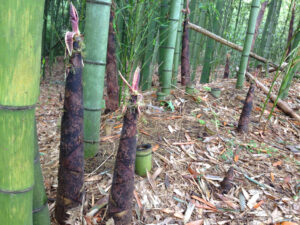 The second theory is that Japanese Timber takes 20 years to size up according to Wade Bennett of Rock Ridge Nursery in Washington State. However, this Japanese timber was planted in 1998 or 1999. It has had time to size up.
The second theory is that Japanese Timber takes 20 years to size up according to Wade Bennett of Rock Ridge Nursery in Washington State. However, this Japanese timber was planted in 1998 or 1999. It has had time to size up.
Conclusions:
Expectations: People say of bamboo “watch out; it will take over” (vigorous) and “you can’t kill it” (tough). In fact, it is a crop with specific requirements: warm location, ample humidity, ample irrigation during growing season, fertilizer, ample organic fertilizer, mulch, yearly thinning, no competition from weeds especially vines and grasses.
Location: Plant bamboo where the soil warms quickly in spring. Most bamboos will not grow in saturated soil.
Disease: yes, bamboo can get debilitating disease. And extension agents can not identify the disease(s).
Moisture: Rhizomes rot in saturated soil.
Time and Money: In 2014, I planted my own bamboo in Hawkinsville Georgia. I spent less time and resources caring for the mature bamboos from which I derived my data from 2014 to the present.
